*Switch language to french for french version of the article*
Friday 26th of November 2021. I am in Berlin (Germany) for a research trip related to my PhD project and the first place I go to visit is the Humboldt Forum: the newly built and opened museum in central Berlin, on the Museum Island. For months I had been following the case of the Humboldt Forum’s reopening which had, for sure, been making noise in the museum world and has, since the project of its creation, been a very controversial project.

The Berlin Palace in 1900 seen from the Lustgarten (colorised postcard).
The architecture brings together the old and the new with the reconstruction of three of the baroque façade of the Berlin Palace which was the main residence of the House of Hohenzollern, a German royal dynasty, from 1443 to 1918. After the fall of the monarchy, the palace was bombed during the Second World War before being destroyed by the Eastern German government in 1950. In 1976, a new architecture was built at the same location: the Palace of the Republic. It was the main building for the East German government before it was demolished in 2008 for it was considered controversial for its political and historical legacy. In place of both the Berlin Palace and the Palace of the Republic, now stands the Humboldt Forum which was built by Italian architect Franco Stella and finished building in 2020, as a reinterpretation of both architectures that occupied this very location in the past.
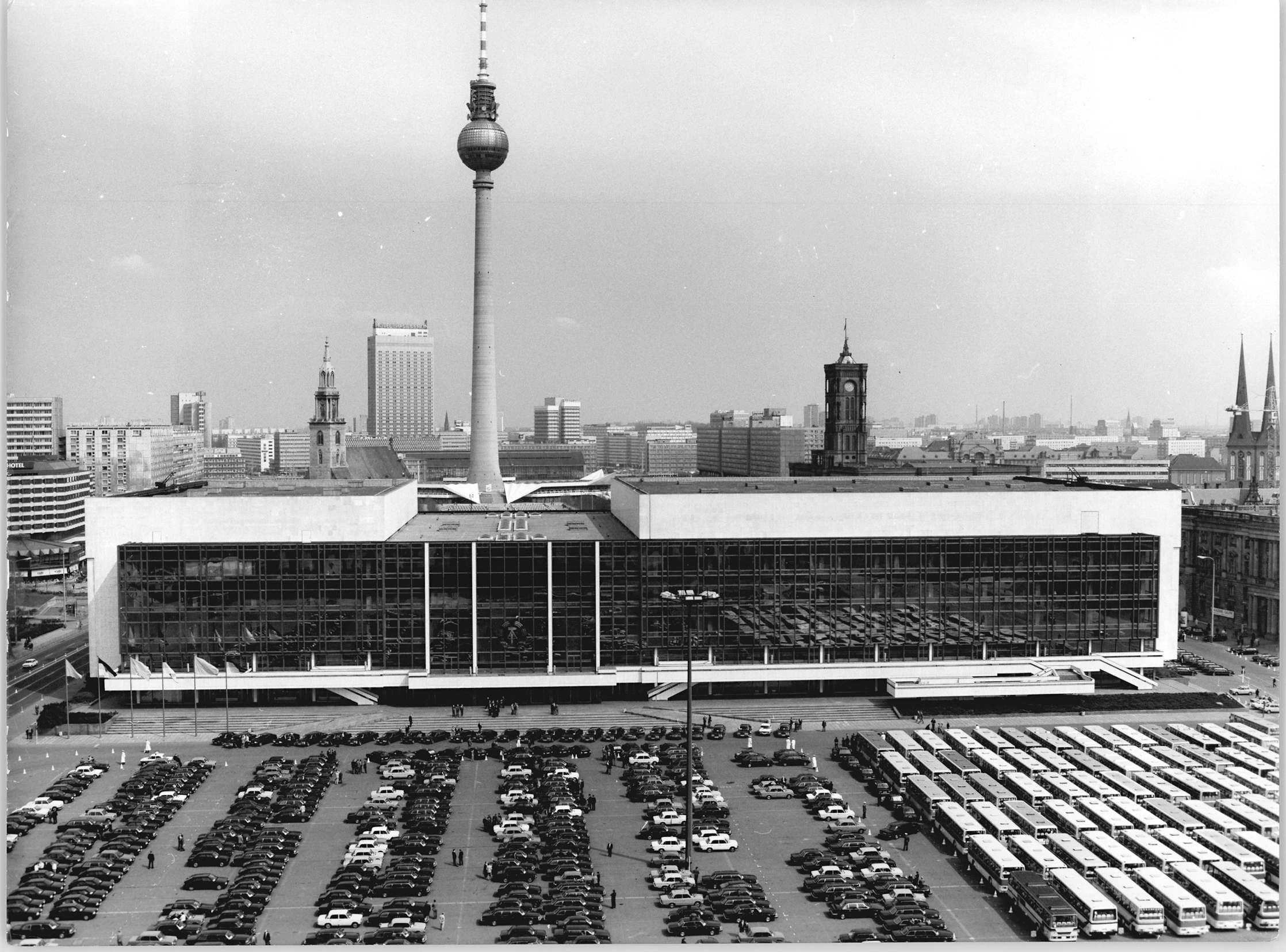
Palace of the Republic © Bundesarchiv Bild/Heinz Junge
The new museum’s leitmotiv is about ‘connecting differences’ and it aims at creating an institution which displays the cultures of the world from Antiquity to nowadays. With the Humboldt Forum, Berlin created a building based on the concept of the universal museum for the dialogue of cultures and peoples; a space “for a free exchange of ideas”.1
Gathered in the Humboldt Forum are the Prussian Heritage foundation, the museum of Ethnology and the museum for Asian cultures, the city museum, the Humboldt University and the Humboldt Forum foundation. With such an ambitious project, the Humboldt Forum positions itself as conveying an encyclopaedical vision which is not without reminding the works conducted by the Humboldt brothers. Wilhelm (1767-1835) and Alexander (1769-1859) von Humboldt were respectively a philosopher, linguist and minister and a geographer, naturalist and explorer. Wilhelm created the Humboldtian model of higher education which advocates for the combination of research and studies while Alexander promoted a romantic ideal of science known as Humboldtian science. Alexander is also known for his exploration of the Americas which ties in with the ethnology museum hosted in the Humboldt Forum and which is at the core of this article. Both of them are embedded in the institution, not only through their name but also as the Humboldt Forum claims to be inspired by their cultural and scientific programme as renowned scholars, reformers and visionaries.2 This discourse about the Humboldt brothers is linear throughout museum displays and installations, praising their achievements and never questioning their role in the colonial endeavour, especially in the case of Alexander’s explorations. However, and as reminded by the Nigerian writer Chimamanda Ngozi Adichie who spoke at the grand opening of the museum of Ethnology and the museum for Asian cultures on 22 September 2021, telling “the universal story of the human race from multiple perspectives […] is a commendable idea, but it is incomplete [if we do not] confront the issue of power: […] Who tells the story, who is the teller and who is told about?”3
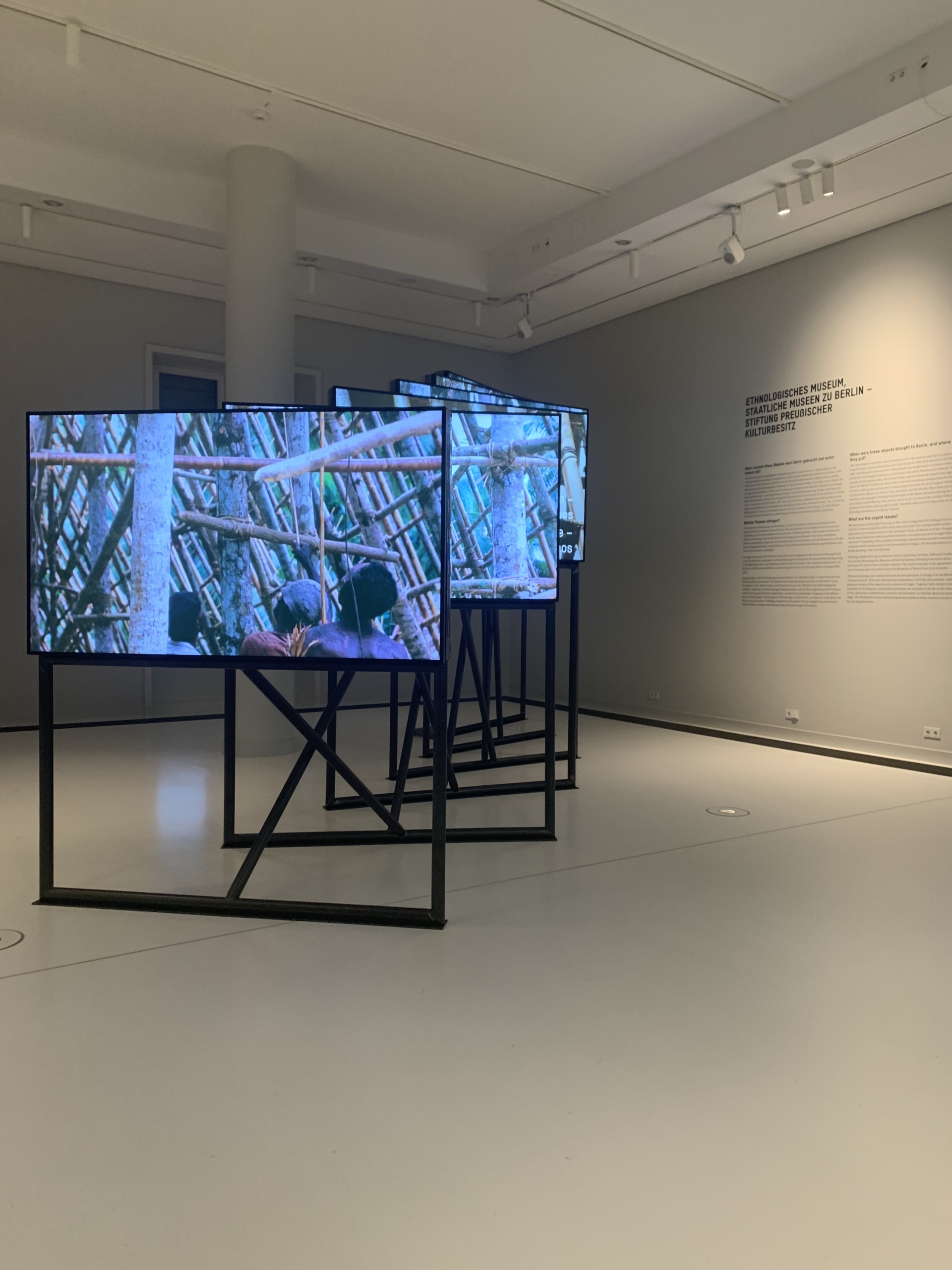
One of the entrance rooms to the exhibition of the museum of ethnology, Humboldt Forum, November 2021. © Photograph: Clémentine Débrosse
The reason for most of the controversies of the Humboldt Forum aside from the recreation of an architecture clearly referring to imperialism and colonialism is linked to the museum of Ethnology – once set in Dahlem where storages still are – which now is part and parcel of the institution. Indeed, the collections which consist of arts from Africa, Oceania and the Americas are controversial in many aspects: whether they were looted, are under calls for repatriation, or often both at the same time. The museum opened its doors on the 23rd of September 2021 but only part of it is actually open, with the Americas collection and more of the Africa and Oceania displays to be opened in the spring or summer of 2022.
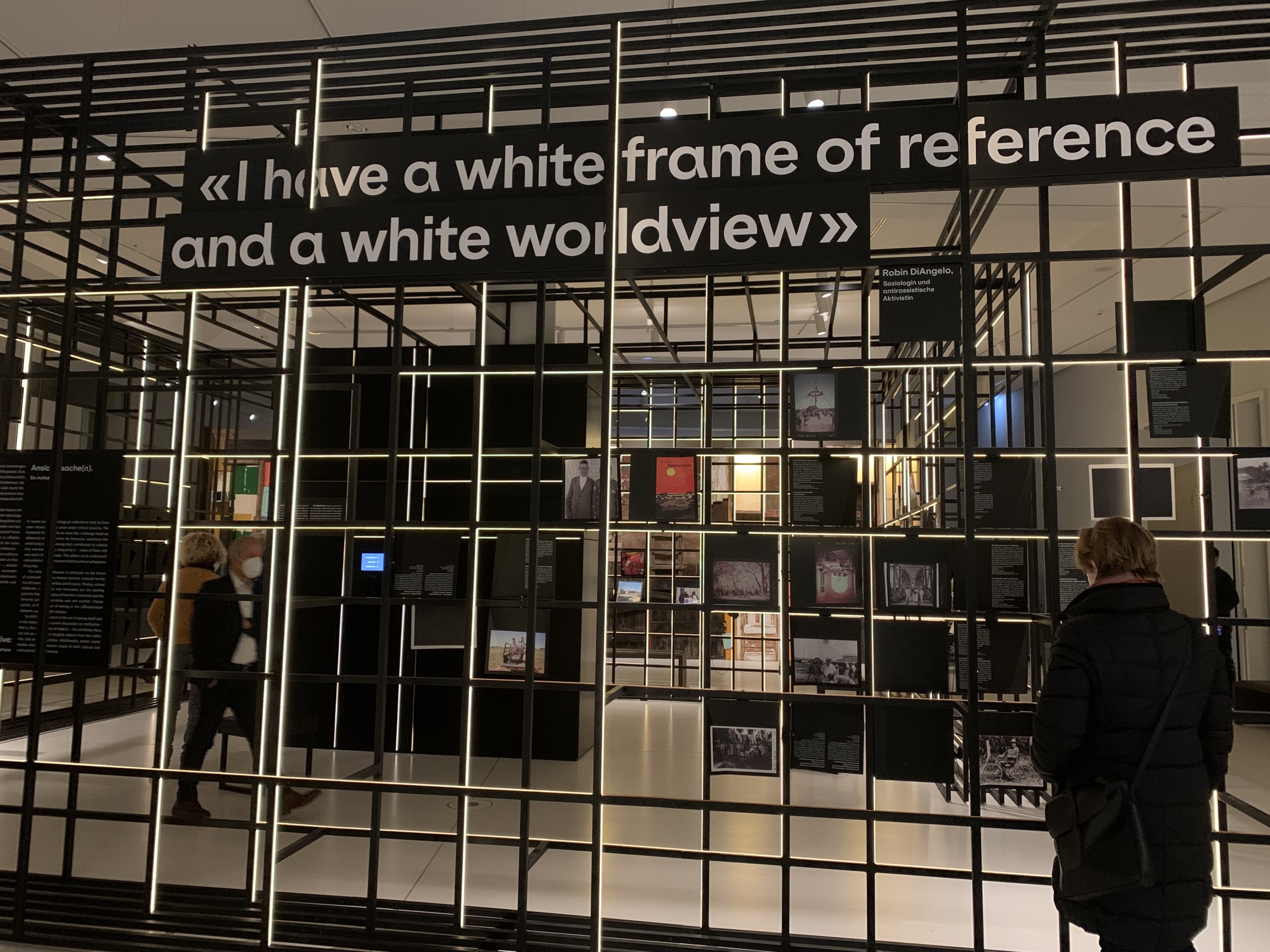
First room of the museum of ethnology exhibition, Matter(s) of Perspective: An Overture, Humboldt Forum, November 2021. © Photograph : Clémentine Débrosse
Arriving on the 2nd floor of the museum, which like any other is distributed by both stairs and escalators in an all-marble environment, we enter the museum of Ethnology through glass doors into a room of introduction with a screen installation and introductory texts on the wall. The display really only starts on the following room. There, a metal cage-like structure stands in the middle of the room with quotes such as “I have a white frame of reference and a white worldview”4 in big and bold letters. Through the metallic structure are displayed ethnographic photographs which depict the German colonies with explanatory labels which are systematically bilingual in German and English. This installation, called Matter(s) of Perspective: An Overture displays some of the archival material which is in the collections of the museum of Ethnology. It comprises photographs but also videos and audio recordings such as the “reflections” of several descendants of men and women (missionaries, governors, society directors) who were involved in the colonization of the Pacific under Germany’s government with a focus on New Guinea and Samoa who were important German colonies. By integrating reproductions rather than originals, the museum explains that they want “to shift the focus back to the act of seeing itself and in the interest of the current discussion on restitution – that is, the repatriation of objects – [that] the exhibition focuses not on “things” or tangible objects from the collection”.5 Certainly a commendable decision, but one could argue that the reproductions are only those of photographs and paper materials, often displayed as reproductions in museums for practical reasons. It is interesting to see that the museum discusses the importance of reproduction in the discussions around repatriation but while it is certainly a first step, shouldn’t this discussion be happening around some of the contested artefacts. On this matter, while most of the claims for repatriation concern African objects, the spotlight was directed on Pacific objects too!

Room of the People and the Sea: Oceania, the Luf boat is at the back of the picture, Humboldt Forum, November 2021. © Photograph: Clémentine Débrosse
In the following room, dedicated to The People and Sea of Oceania, there is a sudden change of ambiance from dark and library-like to a light blue gigantic room – which obviously echoes the ocean, as is recurrently the case with Oceania displays. The room is displayed on two floors with stairs that go down to approach the boats which are exhibited. You can see them from above, on the “balcony” or go down to walk next to them, close enough to touch them (but that is not an encouragement to do so). Among these boats, the largest one comes from the island of Luf which belongs to Hermit Islands situated to the North of the Island of New Guinea and the West of the Bismarck Archipelago, and has been under the radar of journalists and academics for the past months as titled by newspapers such as The Times: “Berlin museum’s star exhibit ‘looted in genocide’”.6 Indeed, the boat was “taken” by Germans at the wake of a punitive expedition which happened in 1882-83. According to the Humboldt Forum’s website, the boat was purchased by Max Thiel from Hernsheim & Co in 1903. However, the period of “purchase” having happened after the eradication of the larger part of the population from the Island leads to think that the colonial yolk in place unlikely allowed for a simple and amicable transaction. While the Luf community does not make any claims for repatriation of the boat, they want to repatriate the knowledge of boat-making that was associated with its construction. The Humboldt forum is heavily engaging with provenance research as is shown throughout the rooms with panel that signal this ongoing research around certain objects. The constant link and exchange with communities is therefore essential and we can only hope that funds will be allocated for the members of the Luf community to make the trip to Berlin for the rekindling of their own cultural knowledge.

Ambisonic room during the playing of Christof Vondereau's creation, The Well of the Sun, Humboldt Forum, November 2021. ©Photograph: Clémentine Débrosse
The display then shows two rooms dedicated to the Arts of Africa and Cameroon before opening to a spaceship-like room: all white, with white round seats on a grey carpet and height small screens when considering the size of the room. This room holds an ambisonic display which allows for the spatial transcribing of sounds that were recorded with this very technology: you can for example hear not only the steps of someone walking, but you can hear these steps spatially and therefore have a sense of where this person is walking in relation to your own position, whether it is just next to you, above your head or ahead on the right. This room which comes in conjunction with the display of the ethnomusical collection of the museum plays several audio and video pieces which were created for this space, one of which is related to the Pacific. Christof Vonderau, a berlin-based composer and classical guitarist created an operatic piece called The Well of the Sun by using texts from the archives of Gerd Koch (1963/64), Sir Arthur Grimble (1951), Captain Charles Wilkes (1845) and from the U.S Atoll Report (1960) for tenor, baritone and concert guitar. This composition is associated to videos of Pacific beaches and drawings of string figures originating from Kiribati (Micronesia) which would accompany “the story of the creation of the world, the departure for the sea, the poems of lovers, the contemplation of the sunset, the ceremonial path to the afterlife, tales of the realm of the sea, the stars, the playful view of nature. […] Performed on the beach, they also accompanied the arrival of the first Europeans.”7 While the label tries to connect the music and images by asking questions such as “Is there more closeness or more distance between the islands of Kiribati and the industrial metropolises due to the diversity of encounter and climate change”, I do not see how any visitor can relate with such questioning by attending this audio-visual session. While the futuristic aspect is intriguing and maybe appealing too, it is hard to truly engage with this work – especially when, like me, you don’t speak German.
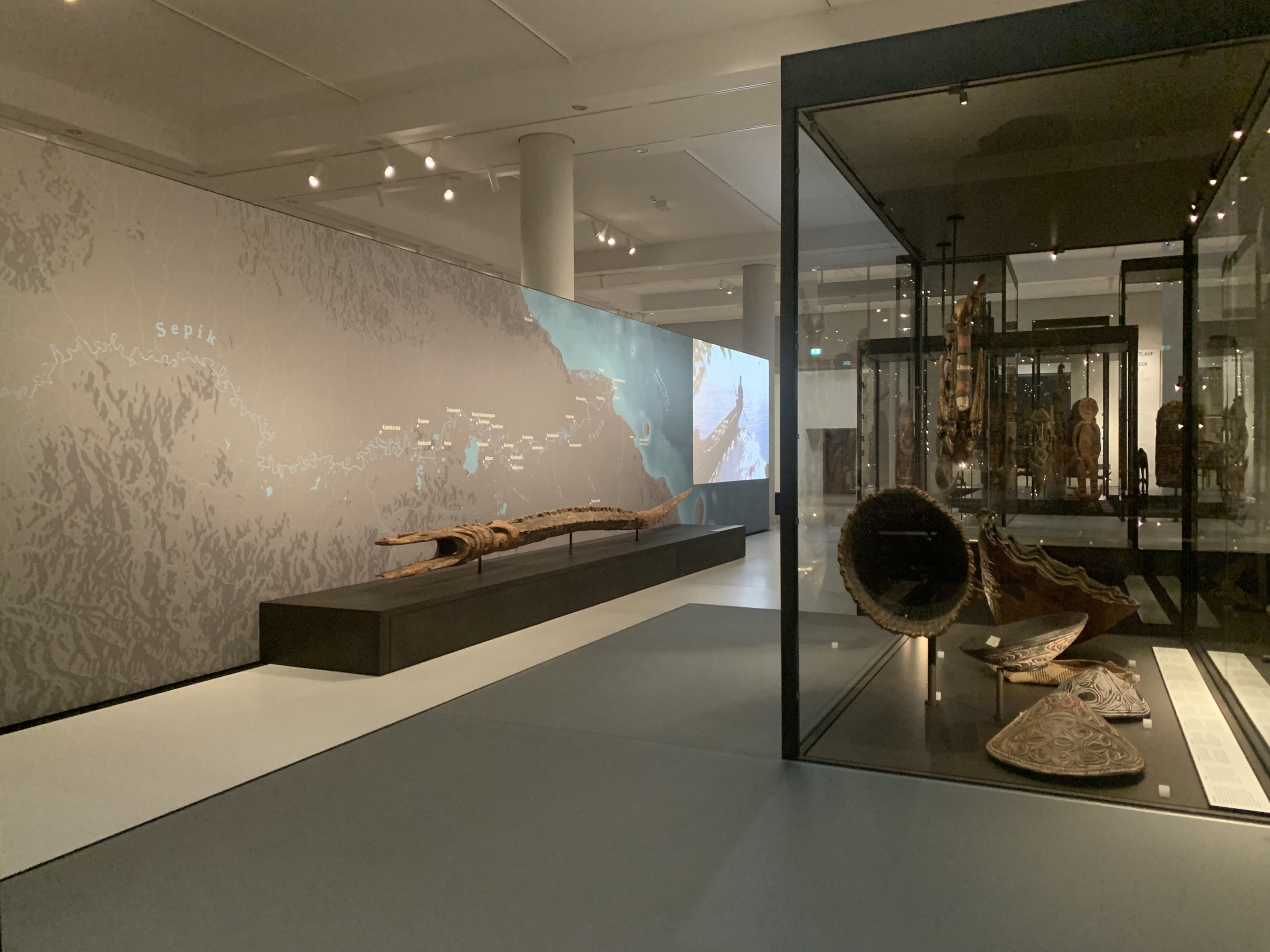
View from the exhibition on the Sepik river at the museum of Ethnology, Humboldt Forum, November 2021. © Photograph: Clémentine Débrosse
After this musical interlude, another two spaces exhibit objects, and these are specifically dedicated to Oceania. The first of these two spaces is mostly dedicated to New Guinea with focuses on the Sepik region and New Ireland which were German territories and where a considerable amount of artefacts were collected. I think it is safe to say that most of the objects on display were already displayed in the former museum of ethnology in Dahlem for those of you who have visited it. However, the museography is very different, and as for the rest of the museum, everything looks very new and expensive with a combination of glass cases and metallic structures. Importance is also given to the use of screens that show contemporary videos and films shot in New Guinea in both English and pidgin language with German subtitles. An emphasis is made on the geography of the locations exhibited with a large map of the Sepik River at the centre of the room which is put alongside a video showing men on the river. Many of these objects were part of the Sepik exhibition which was exhibited in Berlin and Paris in 2014 and 2015. 8
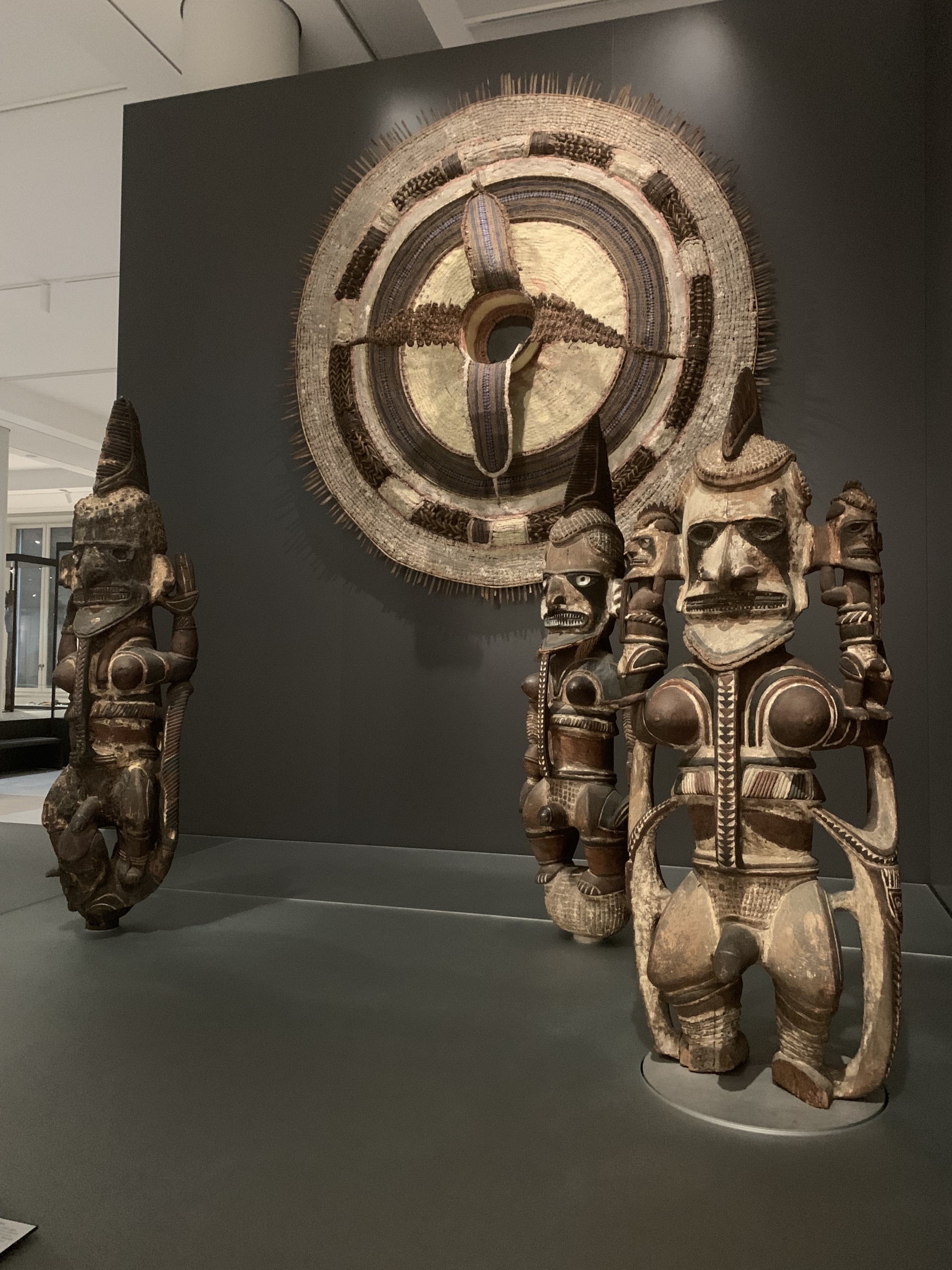
Group of three Uli sculptures and a vavara, Humboldt Forum, November 2021. © Photograph: Clémentine Débrosse
At the back of the room is a display focusing on New Ireland with a large case showing many Malangan sculptures and a video in front of them presenting a contemporary Malangan ceremony. On the side of this display, I was suddenly surprised to see the display of three Uli figures and a vavara were exhibited just like they were in Dahlem when I last saw them in 2013. However, the skull at the centre of the vavara was gone in the Humboldt Forum. While the positioning of museums on the display of human remains is partly responsible for this decision, I was told that the display of the vavara with the skull in Dalhem was a museological recreation as the skull and the vavara had not even been collected as complimentary artefacts which was sufficient in itself not to display the skull anymore.


View of the "open storage" of the Oceania collections as well as the tactile table which gives access to the database, Humboldt Forum, November 2021. © Photograph: Clémentine Débrosse
Finally, a large part of this room is dedicated to an “Open Storage” of Oceania collections as is the case for the rooms dedicated to Africa and will be the case for the rooms dedicated to the Americas. These displays show artefacts, organised by countries or islands, without any label that help with their identification. The only point of information takes the form of a tactile table which displays all of the catalogue entries in the database of the exhibited artefacts: a game of seek and find then starts if you want to know more about any of these exhibited objects. While this is rather fancy looking, it is certainly very unpractical and is an easy way out for museums to display a lot of objects and give a glimpse in the enormity of their collections. With such displays, the Humboldt Forum presents the collections through the encyclopaedical lens, by showing the diversity of what they hold and echoing to how much more is left hidden in restricted access storages.
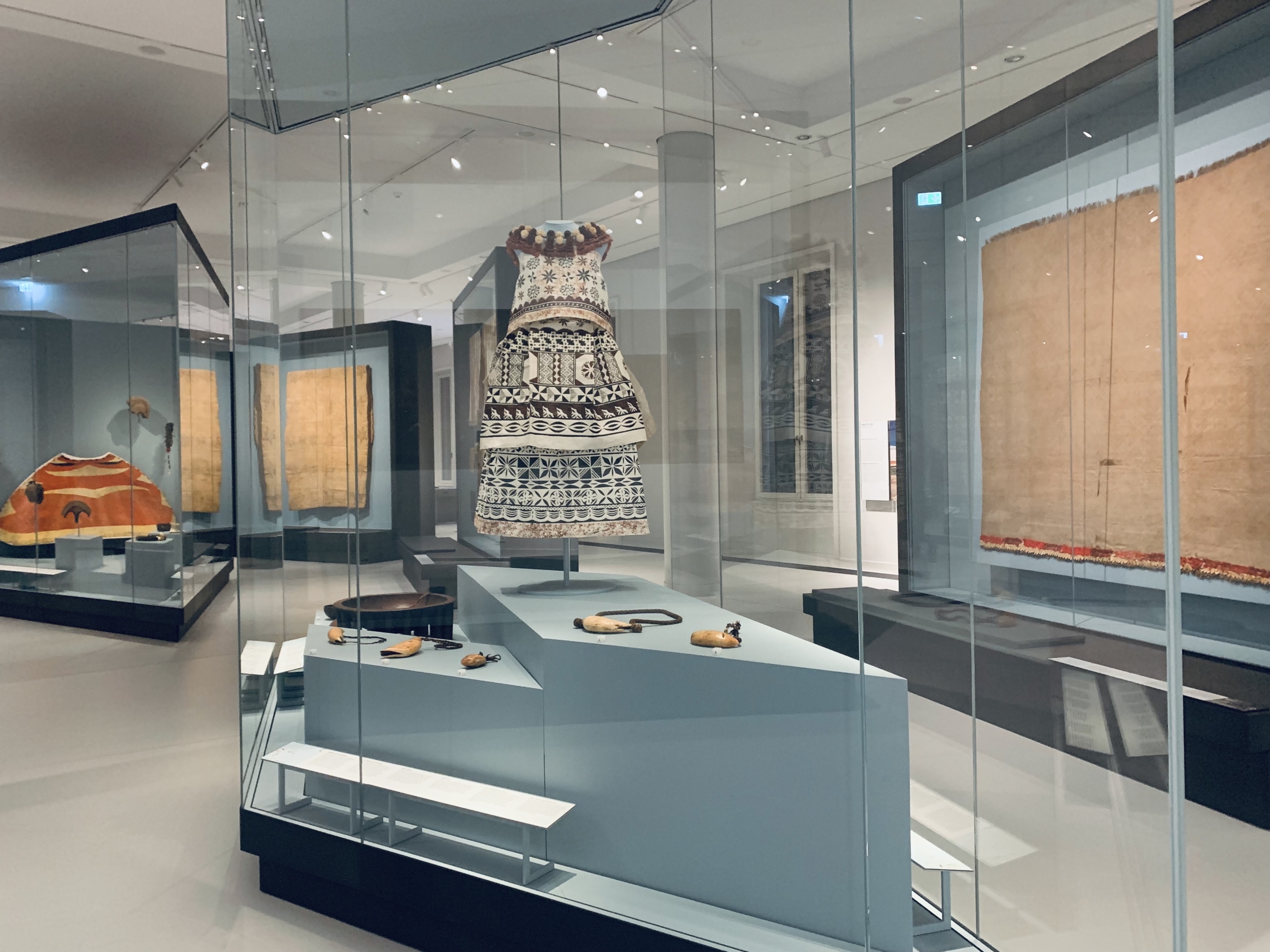
Exhibition of Polynesian objects, Humboldt Forum, November 2021. © Photograph: Clémentine Débrosse
In the last Oceania room which was open at the time of my visit, Polynesia is at the centre of the display, with the return of the ocean blue colour on the back of the display cases. While I do not have much comment to make on the display except for the colour which was not necessary, I noticed the objects’ labels after focusing my attention on a very small To’o. While I knew that the object originated from Tahiti, I noticed that the first word written in place of the origin of the object was “France” before continuing with “French Polynesia, Society Islands”, finishing with “Tahiti”. While it is obviously accurate as Tahiti and French Polynesia are still to this day French territories, one can ask why the emphasis is put on the larger political entity first. Will someone who does not have knowledge on the Pacific colonial history remember the object as being from Tahiti rather than France? I believe that a reversed order would have been more relevant, yet still allowing to express that colonialism is not an over-with enterprise.
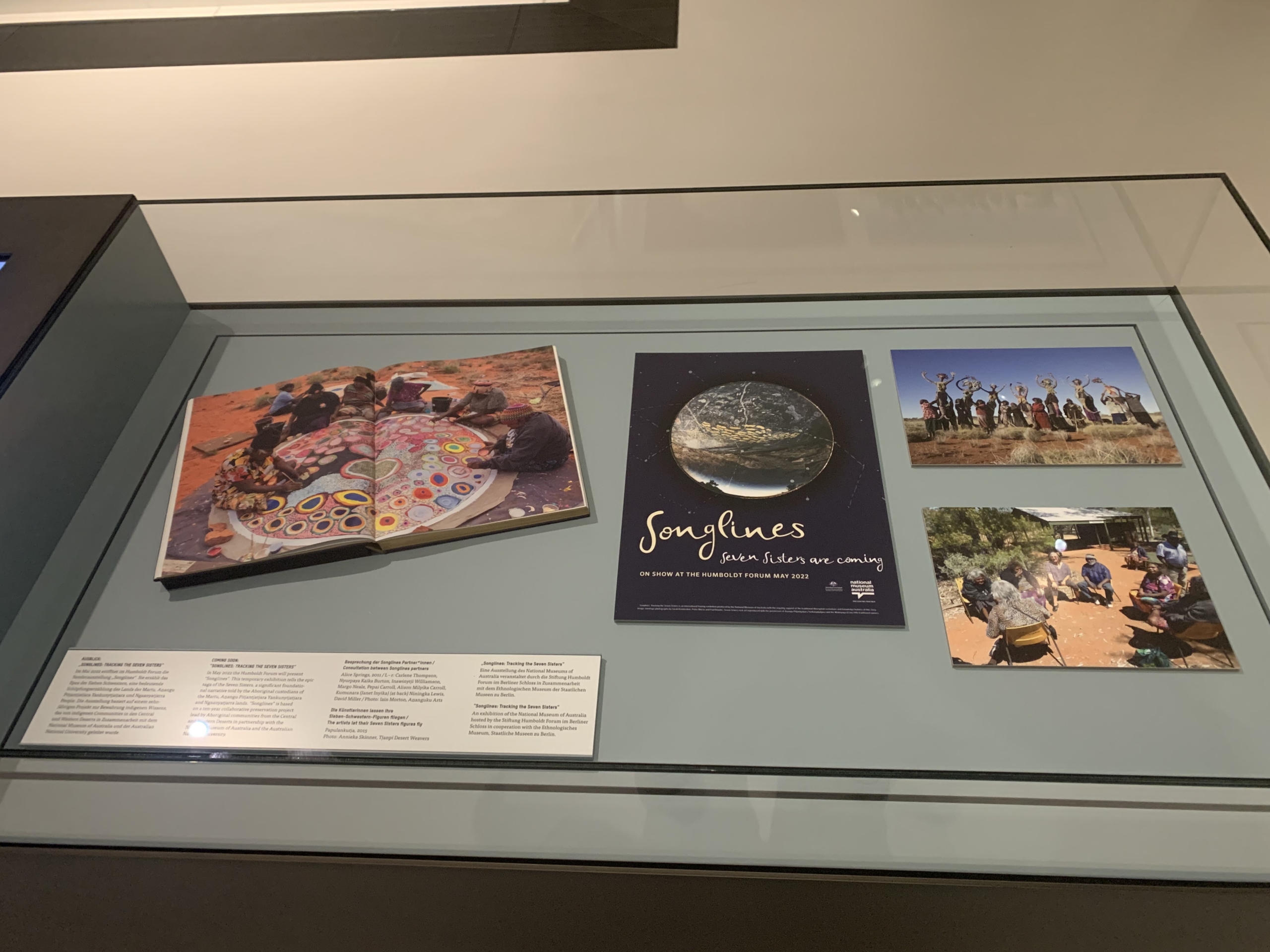
Glass case announcing the Songlines: Tracking the Seven Sisters exhibition, Humboldt Forum, November 2021. © Photograph: Clémentine Débrosse
On the side of this room can be found some Aboriginal paintings from Australia, as well as a display case announcing the forthcoming exhibition Songlines: Tracking the Seven Sisters which will be on show this coming summer at the Humboldt Forum.
I believe that to the question I asked in the title of this article you expect an answer, and I am not sure I can give you one. I visited this space having in mind all the controversies, calls for repatriations, protests, articles that are against such an institution and while I find a lot of these controversies justified, I do not think anyone needs another article to tell them whether such an institution should have existed or not: as a matter of fact it exists.
If 644 million euros were spent into building (or re-building) this luxurious palace, we might rather try to see if the Humboldt Forum will, in the years to come and in the words of Chimamanda Ngozi Adiche, face its pasts and bring in some light by showing courage: the courage to hear voices, take criticisms followed by actions, the courage to say, we were wrong and the courage to believe that it can be better. “We cannot change the past, but we can change our blindness to the past”.9
Clémentine Débrosse
Cover picture: The east and north facades of the Humboldt Forum © Stiftung Humboldt Forum im Berliner Schloss / Photo: Alexander Schippel
1 Chimamanda Ngozi Adiche, speech during the opening ceremony of the ethnology museum at the Humboldt Forum on 22 September 2021. https://www.youtube.com/watch?v=gMRv5xhMCo4&t=33s
2 Text of the label located on the esplanade of the museum.
3 Chimamanda Ngozi Adiche, speech during the opening ceremony of the ethnology museum at the Humboldt Forum on 22 September 2021. https://www.youtube.com/watch?v=gMRv5xhMCo4&t=33s
4 DIANGELO, R., 2018. «White Fragility: Why It’s So Hard for White People to Talk about Racism”.
5 Label of the museum.
6 WATERFIELD, B., 2021. “Berlin museum’s star exhibit ‘looted in genocide’”. The Times. https://www.thetimes.co.uk/article/berlin-museum-star-exhibit-south-seas-ship-looted-genocide-3fqtz0pjh
7 Label of the museum.
8 PELTIER, P., SCHINDLBECK, M., KAUFMANN, C. (dir), 2015. Sepik: Arts de Papouasie-Nouvelle-Guinée. Paris, Skira/Musée du Quai Branly.
9 Chimamanda Ngozi Adiche, speech during the opening ceremony of the ethnology museum at the Humboldt Forum on 22 September 2021. https://www.youtube.com/watch?v=gMRv5xhMCo4&t=33s
To go further:
- Article focusing on the Luf boat written by the ethnology museum that includes a video of the Luf community https://www.smb.museum/en/museums-institutions/ethnologisches-museum/collection-research/the-outrigger-boat-from-the-island-of-luf/
- Speech made by Chimamanda Ngozi Adiche during the opening ceremony of the ethnology museum at the Humboldt Forum on 22 September 2021: https://www.youtube.com/watch?v=gMRv5xhMCo4&t=33s
- ADAMS, G. K., 2021. « ‘Opinions are changing’: Berlin’s new cultural venue tackles colonial legacies ». Museums association. https://www.museumsassociation.org/museums-journal/news/2021/09/opinions-are-changing-berlins-new-cultural-venue-tackles-colonial-legacies/#
